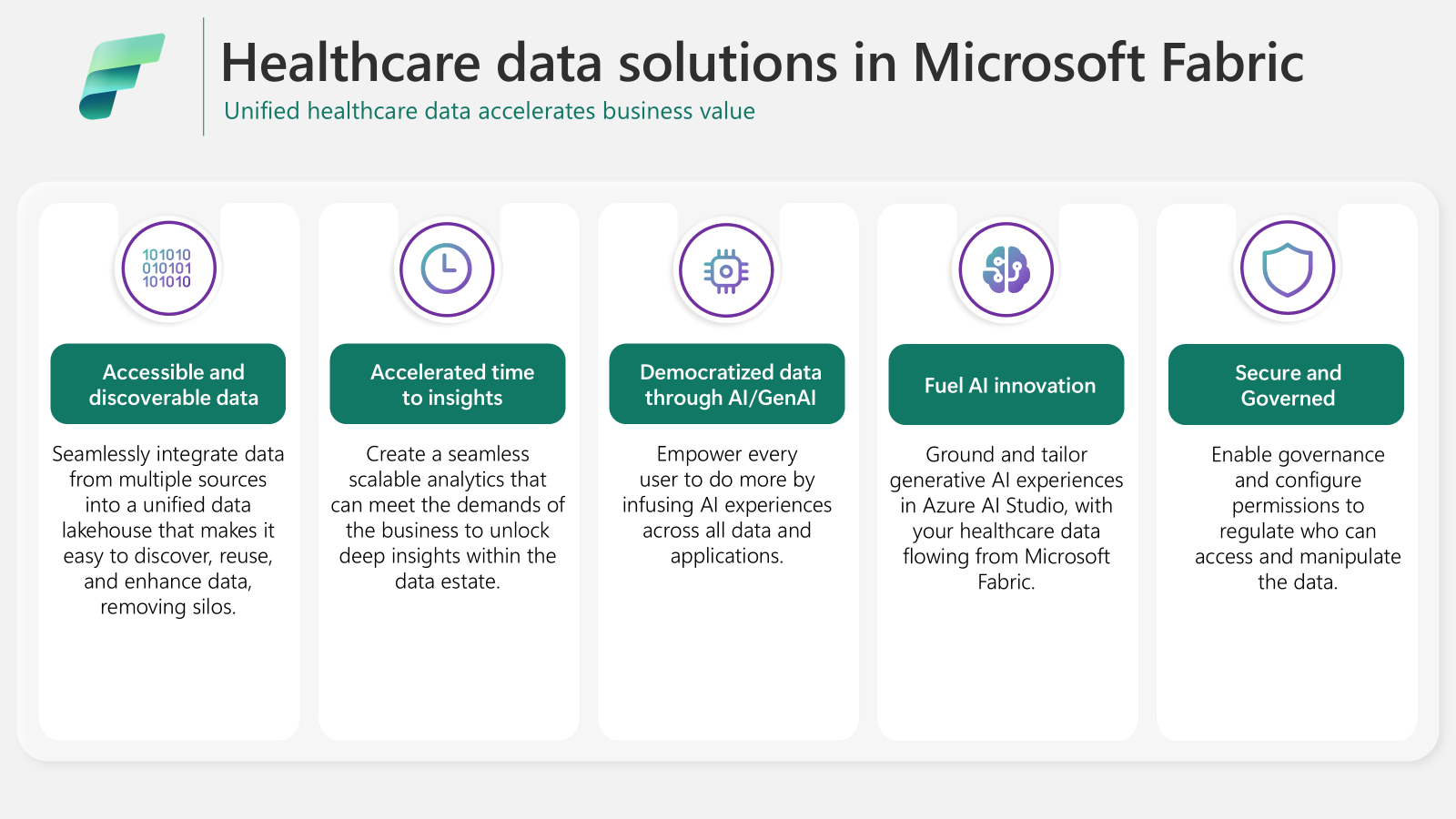Overview of healthcare data solutions in Microsoft Fabric
Healthcare organizations need to analyze vast amounts of data to gain valuable insights. But this data is often unstructured or semi-structured, which makes them hard to access and use. Currently, healthcare organizations face the following challenges with data and analytics:
Unstructured and inaccessible data: A research report from HfS and Accenture indicates that 50% to 90% of data within most healthcare providers is unstructured and largely inaccessible. This segregation limits advances in medical treatments and technologies. It also imposes constraints on the ability to adhere to regulatory compliance standards.
Limited view into patient experiences: Healthcare organizations find it difficult to forecast emergencies, improve diagnostics, and optimize treatments based on clinical patterns.
Difficulty accessing the power of insights: Healthcare providers spend 60% to 70% of valuable analysis time ingesting healthcare data, according to a report by the PwC Health Research Institute.
To address these challenges effectively, organizations need to improve their ability to harness data for uncovering clinical insights and implementing value-based care models. They need to use different types of data, such as:
- Clinical data
- Engagement data
- Imaging data
- Genomics
- Conversational
- Claims
- SDOH (Social determinants of health)
Taking into account this industry landscape, we're introducing Healthcare data solutions in Microsoft Fabric, our enterprise analytics solution built atop the Microsoft Fabric platform. Microsoft Fabric lets you manage your data in one place with a suite of analytics experiences that work together seamlessly. It provides a comprehensive ecosystem for data integration, data engineering, real-time analytics, data science, and business intelligence needs without compromising your data privacy and security. For more information, see What is Microsoft Fabric?
Healthcare data solutions in Microsoft Fabric help you accelerate time to value by addressing the critical need to efficiently transform healthcare data into a suitable format for analysis. With these solutions, you can conduct exploratory analysis, run large-scale analytics, and power generative AI with your healthcare data. By using intuitive tools such as data pipelines and transformations, you can easily navigate and process complex datasets, overcoming the inherent challenges associated with unstructured data formats.
Tip
To watch these solutions in action, see Healthcare data solutions in Microsoft Fabric.
The solutions enable you to break down data silos and harmonize disparate healthcare data in a single unified store where analytics and AI workloads can operate at scale. These solutions help you transform unstructured or semi-structured healthcare data into a tabular shape that can be persisted in the data lake, ensuring accessibility and usability for continued analysis. By deploying the solutions directly to a Fabric workspace, you can harness the power of autoscaling capabilities inherent to built-in serverless SQL pools, optimizing both performance and scalability. This integration enables you to apply the full spectrum of analytical tools within a familiar workspace environment, enhancing productivity and driving informed decision-making. With the new features in healthcare data solutions, you can unlock actionable insights from your data, drive innovation, and improve patient outcomes.
Healthcare data solutions in Microsoft Fabric currently include the following solutions/capabilities:
Healthcare data foundations: Set up your healthcare data estate quickly with FHIR data standards and ready-to-run data pipelines that are designed to efficiently structure data for analytics and AI/machine learning modeling. For more information, see Overview of healthcare data foundations.
Discover and build cohorts (preview): Explore multi-modal data using natural language queries and build cohorts for downstream research and AI innovation. For more information, see Overview of discover and build cohorts (preview).
Azure Health Data Services - Data export: Bring your Fast Healthcare Interoperability Resources (FHIR) data to Fabric OneLake from the Azure Health Data Services FHIR service. For more information, see Overview of Azure Health Data Services - Data export.
OMOP transformations: Prepare data for standardized analytics through Observational Medical Outcomes Partnership (OMOP) open community standards. For more information, see Overview of OMOP transformations.
DICOM data transformation: Bring your Digital Imaging and Communications in Medicine (DICOM) data to OneLake. For more information, see Overview of DICOM data transformation.
CMS claims data transformations (preview): Bring your CMS CCLF (Centers for Medicare & Medicaid Services Claim and Claim Line Feed) data to OneLake. For more information, see Overview of CMS claims data transformations (preview).
SDOH datasets - Transformations (preview): Bring your Social determinants of health (SDOH) datasets to OneLake. For more information, see Overview of SDOH datasets - Transformations (preview).
Unstructured clinical notes enrichment (preview): Use Azure AI Language's Text Analytics for health services to extract and add structure to unstructured clinical notes for analytics. For more information, see Overview of unstructured clinical notes enrichment (preview).
Dynamics 365 Customer Insights - Data preparation: Connect Dynamics 365 Customer Insights to your OneLake on Fabric for creating patient or member lists for outreach. For more information, see Overview of Dynamics 365 Customer Insights - Data preparation.
Care management analytics (preview): Gain insights into high-risk and rising-risk patients, enabling timely interventions with appropriate care plan actions. For more information, see Overview of care management analytics (preview).
Patient outreach analytics (preview): Bring your marketing data from Dynamics 365 to OneLake, harmonize them with patient data in FHIR, and use Power BI templates to improve patient engagement. For more information, see Overview of patient outreach analytics (preview).
Healthcare data solutions in Microsoft Fabric include sample data that you can use to test the solutions. Alternatively, you can also ingest your own data directly into OneLake.
